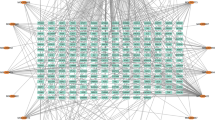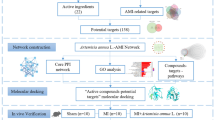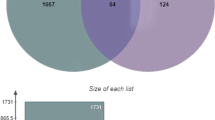Abstract
Hawthorn leaf has shown therapeutic effects in the patients with myocardial ischemia. Our study combines network pharmacology, molecular docking techniques, and in vitro experiment with the aim of revealing the mechanism of hawthorn leaves in the treatment of myocardial ischemia. The active ingredients and corresponding targets of hawthorn leaf through Traditional Chinese Medicine System Pharmacology and Swiss Target Prediction databases. Targets related to myocardial ischemia were retrieved by Gene Card, Online Mendelian Inheritance in Man, Disgenet, and Therapeutic Targets Database databases. Cytoscape software was used to construct an ingredient–target–organ network and enrichment analysis of common targets was analyzed. Molecular docking verification of the core compound and target interactions was performed using MOE software. In vitro cell experiment was performed to verify the findings from bioinformatics analysis. Six active components and 107 potential therapeutic targets were screened. The protein–protein interaction network analysis indicated that 10 targets, including AKT1 and EGFR, were hub genes. Quercetin, kaempferol and isorhamnetin were taken as core active components. Through pathway enrichment analysis, nearly 455 Gene Ontology entries and 77 Kyoto Encyclopedia of Genes and Genomes pathways were obtained, mainly including PI3K/Akt, estrogen and other signaling pathways. Molecular docking prediction showed that three main active ingredients were firmly combined with the core targets. Cellular experiments showed that quercetin alleviated oxidative damage in cells and regulated the expression of PI3K, P-AKT/AKT and Bax/Bcl-2 proteins. This study identified the potential targets of Hawthorn leaf against myocardial ischemia using network pharmacology and in vitro verification, which provided a new understanding of the pharmacological mechanisms of Hawthorn leaf in treatment of myocardial ischemia.











Similar content being viewed by others
Data Availability
Author can confirm that all relevant data are included in the article and/or its supplementary information files.
Change history
25 April 2024
A Correction to this paper has been published: https://doi.org/10.1007/s12012-024-09851-8
References
National Pharmacopoeia Commission. (2015). Pharmacopoeia of the people’s republic of China. China Medical Science and Technology Press.
Wu, J., Peng, W., Qin, R., & Zhou, H. (2014). Crataegus pinnatifida: Chemical constituents, pharmacology and potential applications. Molecules (Basel, Switzerland), 19(2), 1685–1712. https://doi.org/10.3390/molecules19021685
Wen, K., Fang, X., Yang, J., Yao, Y., Nandakumar, K. S., Salem, M. L., & Cheng, K. (2021). Recent research on flavonoids and their biomedical applications. Current Medicinal Chemistry, 28(5), 1042–1066. https://doi.org/10.2174/0929867327666200713184138
Chen, Z., & Zhang, S. L. (2021). The role of flavonoids in the prevention and management of cardiovascular complications: a narrative review. Annals of Palliative Medicine, 10(7), 8254–8263. https://doi.org/10.21037/apm-21-1343
Zang, Z. Z., Chen, L. M., Liu, Y., Guan, Y. M., Du, Q., Xu, P., Shen, Q., Yang, M., Liu, H. N., & Liao, Z. G. (2021). Uncovering the protective mechanism of the volatile oil of Acorus tatarinowii against acute myocardial ischemia injury using network pharmacology and experimental validation. Evidence-Based Complementary and Alternative Medicine: ECAM, 2021, 6630795. https://doi.org/10.1155/2021/6630795
Finegold, J. A., Asaria, P., & Francis, D. P. (2013). Mortality from ischaemic heart disease by country, region, and age: Statistics from World Health Organisation and United Nations. International Journal of Cardiology, 168(2), 934–945. https://doi.org/10.1016/j.ijcard.2012.10.046
Xie, F., Wu, Y. Y., Duan, G. J., Wang, B., Gao, F., Wei, P. F., Chen, L., Liu, A. P., & Li, M. (2021). Anti-myocardial ischemia reperfusion injury mechanism of dried ginger-aconite decoction based on network pharmacology. Frontiers in Pharmacology, 12, 609702. https://doi.org/10.3389/fphar.2021.609702
Practise Guideline. (2020). For integrated management of cardiovascular diseases in primary hospitals. Chinese Medical Journal, 12(08), 1–73.
Li, M. Y. (2019). Progress of Chinese and Western medicine research on asymptomatic myocardial ischemia in coronary heart disease. Journal of Yellow River Institute of Science and Technology, 02, 7–12. https://doi.org/10.19576/j.issn.1008-5424.2019.02.003
Currò, D., Ianiro, G., Pecere, S., Bibbò, S., & Cammarota, G. (2017). Probiotics, fibre and herbal medicinal products for functional and inflammatory bowel disorders. British Journal of Pharmacology, 174(11), 1426–1449. https://doi.org/10.1111/bph.13632
Luo, L., Wang, H., Huang, G., Zhang, L., Li, X., Ma, C., & Wang, X. (2022). Pharmacological mechanisms of Tinglizi against chronic heart failure determined by network pharmacology and molecular docking. Evidence-Based Complementary and Alternative Medicine: ECAM, 2022, 2152399. https://doi.org/10.1155/2022/2152399
Hu, Y. W. (2021). Target prediction and clinical data validation of Fufang Banmao capsule for treating hepatocellular carcinoma based on network pharmacology. Nanchang University. https://doi.org/10.27232/d.cnki.gnchu.2021.000018
Wu, L., Chen, Y., Chen, M., Yang, Y., Che, Z., Li, Q., You, X., & Fu, W. (2021). Application of network pharmacology and molecular docking to elucidate the potential mechanism of Astragalus-Scorpion against prostate cancer. Andrologia, 53(9), e14165. https://doi.org/10.1111/and.14165
Tang, M. (2021). In vitro pharmacodynamic test study of antimyocardial ischemia of Tianxiangdan based on network pharmacology. Xinjiang Medical University.
Li, Y., & Jeon, J. (2013). Quercetin modulates PTEN-Akt pathway to inhibit H2O2-induced apoptosis in vascular endothelial cells. Chinese Journal of Atherosclerosis, 12, 1089–1092.
An, H. Y. (2016). Huang L j academic thoughts and clinical experience, and restenosis after interventional treatment of the coronary heart disease clinical research. Beijing University of Chinese Medicine.
Hu, S. S. (2021). The writing committee of the report on cardiovascular health and diseases in China. China Cardiovascular Journal, 26(03), 209–218.
Yue, D. F., & Li, Y. F. (2022). Research progress on the mechanism of action of Chinese medicine and its compound against myocardial ischemia-reperfusion injury. Chinese Pharmacology and Clinical, 06, 224–239. https://doi.org/10.13412/j.cnki.zyyl.20220313.003
Zhao, H., Yuan, L., Chen, Z., Liao, Y., & Lin, J. (2021). Exploring the diagnostic effectiveness for myocardial ischaemia based on CCTA myocardial texture features. BMC Cardiovascular Disorders, 21(1), 416. https://doi.org/10.1186/s12872-021-02206-z
Editorial board of Chinese Journal of Cardiovascular Diseases. (2019). Expert consensus on early antithrombotic therapy and inter-hospital transport in patients with acute coronary syndrome. Clinical Medical Research and Practice (Chin), 4(18), 201.
Ferenczyova, K., Kalocayova, B., Kindernay, L., Jelemensky, M., Balis, P., Berenyiova, A., Zemancikova, A., Farkasova, V., Sykora, M., Tothova, L., Jasenovec, T., Radosinska, J., Torok, J., Cacanyiova, S., Barancik, M., & Bartekova, M. (2020). Quercetin exerts age-dependent beneficial effects on blood pressure and vascular function, but is inefficient in preventing myocardial ischemia-reperfusion injury in Zucker diabetic fatty rats. Molecules (Basel, Switzerland), 25(1), 187. https://doi.org/10.3390/molecules25010187
Chen, L., Sun, L., Liu, Z., Wang, H., & Xu, C. (2016). Protection afforded by quercetin against H2O2-induced apoptosis on PC12 cells via activating PI3K/Akt signal pathway. Journal of Receptor and Signal Transduction Research, 36(1), 98–102. https://doi.org/10.3109/10799893.2015.1049363
Li, S. S., Li, P., Kang, N., Yuan, J., & Li, J. L. (2021). Research progress on the relationship between PI3K/AKT signaling pathway and cardiovascular disease. Beijing Medicine, 43(01), 66–69.
Chu, D., & Zhang, Z. (2018). Trichosanthis pericarpium aqueous extract protects H9c2 cardiomyocytes from hypoxia/reoxygenation injury by regulating PI3K/Akt/NO pathway. Molecules (Basel, Switzerland), 23(10), 2409. https://doi.org/10.3390/molecules23102409
Acknowledgements
We would like to thank the Provincial Science and Technology Plan of Hebei Province (Grant numbers 20372507D), Hebei Provincial Science and Technology Department's "Technological Innovation Guidance Project-Scientific and Technological Work Consultation" (Grant number 2020), and Key discipline Construction Project of Colleges and Universities in Hebei Province (Grant number Ji Jiao Gao [2013] 4).
Funding
The Provincial Science and Technology Plan of Hebei Province (Grant Number 20372507D), Key discipline Construction Project of Colleges and Universities in Hebei Province (Grant Number Ji Jiao Gao (2013) 4).
Author information
Authors and Affiliations
Contributions
(I) Conception and design: JG, YW, XH; (II) Administrative support: HP; (III) Collection and assembly of data: SZ; (IV) Data analysis and interpretation: JG; (V) Manuscript writing: JG, YW, XH; (VI) Final approval of manuscript: All authors.
Corresponding author
Ethics declarations
Competing interests
The authors declare no competing interests.
Ethical Approval
This article does not contain any studies with human participants or animals performed by any of the authors.
Informed Consent
This article does not contain any studies with human participants performed by any of the authors.
Consent for Publication
All authors agree to public. Conflict of Interest: The authors declare that there is no conflict of interest.
Additional information
Handling Editor: Travis Knuckles.
Publisher's Note
Springer Nature remains neutral with regard to jurisdictional claims in published maps and institutional affiliations.
The original online version of this article was revised: In this article the wrong figure appeared as Fig. 1.; the figure should have appeared as shown below.
Supplementary Information
Below is the link to the electronic supplementary material.
Rights and permissions
Springer Nature or its licensor (e.g. a society or other partner) holds exclusive rights to this article under a publishing agreement with the author(s) or other rightsholder(s); author self-archiving of the accepted manuscript version of this article is solely governed by the terms of such publishing agreement and applicable law.
About this article
Cite this article
Gao, J., Wang, Y., Xiong, H. et al. Uncovering the Mechanism of Chinese Hawthorn Leaf on Myocardial Ischemia Based on Network Pharmacology, Molecular Docking Verification, and In Vitro Studies. Cardiovasc Toxicol 24, 171–183 (2024). https://doi.org/10.1007/s12012-024-09825-w
Received:
Accepted:
Published:
Issue Date:
DOI: https://doi.org/10.1007/s12012-024-09825-w




